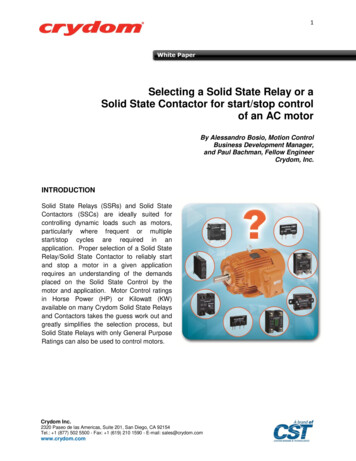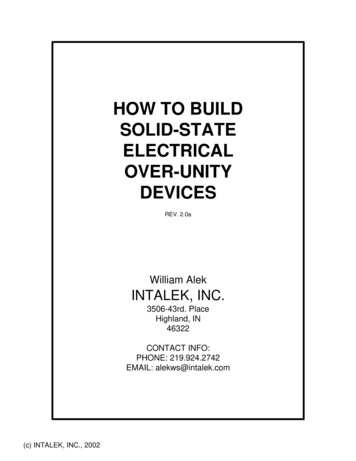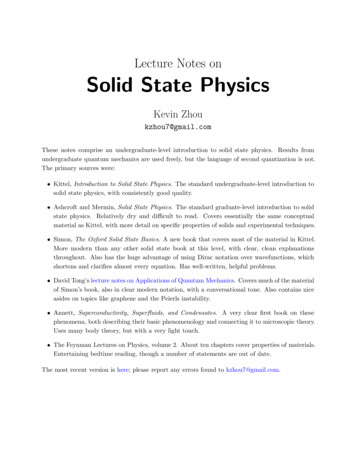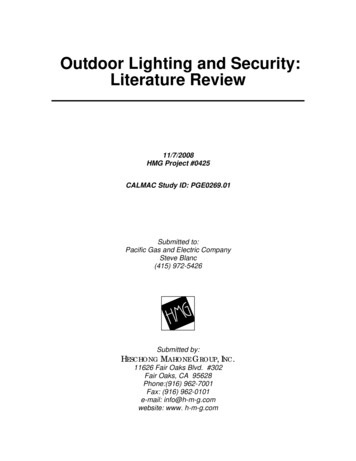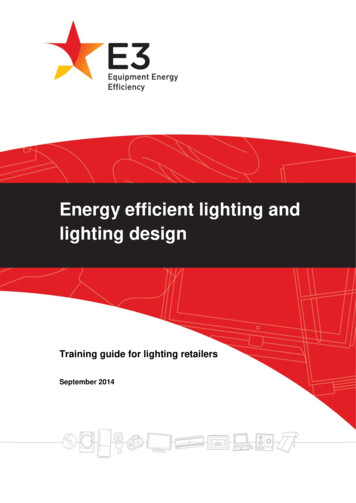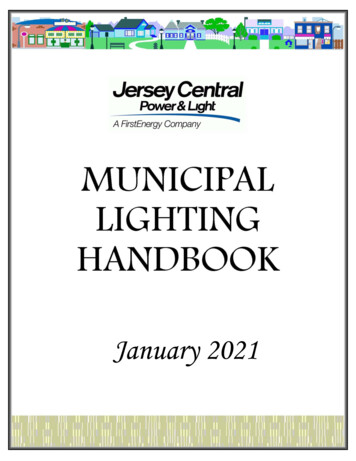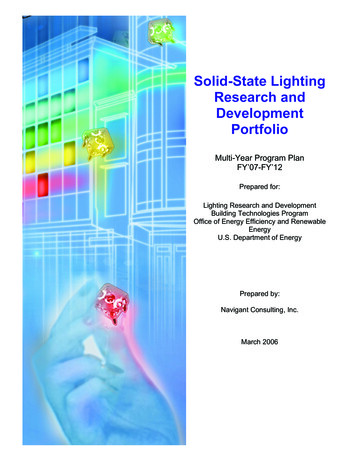
Transcription
Solid-State LightingResearch andDevelopmentPortfolioMulti-Year Program PlanFY’07-FY’12Prepared for:Lighting Research and DevelopmentBuilding Technologies ProgramOffice of Energy Efficiency and RenewableEnergyU.S. Department of EnergyPrepared by:Navigant Consulting, Inc.March 2006
Solid-State Lighting Research andDevelopment PortfolioMulti-Year Program PlanFY’07-FY’12Prepared for:Lighting Research and DevelopmentBuilding Technologies ProgramOffice of Energy Efficiency and Renewable EnergyU.S. Department of EnergyPrepared by:Navigant Consulting, Inc.March 2006
DISCLAIMERThis report was prepared as an account of work sponsored by an agency of the United StatesGovernment. Neither the United States Government, nor any agency thereof, nor any of theiremployees, nor any of their contractors, subcontractors, or their employees, makes any warranty,express or implied, or assumes any legal liability or responsibility for the accuracy, completeness,or usefulness of any information, apparatus, product, or process disclosed, or represents that itsuse would not infringe privately owned rights. Reference herein to any specific commercialproduct, process, or service by trade name, trademark, manufacturer, or otherwise, does notnecessarily constitute or imply its endorsement, recommendation, or favoring by the UnitedStates Government or any agency, contractor or subcontractor thereof. The views and opinions ofauthors expressed herein do not necessarily state or reflect those of the United States Governmentor any agency thereof.i
ACKNOWLEDGEMENTSThe Department of Energy would like to acknowledge and thank all the participants for theirvaluable input and guidance provided to develop the Multiyear Program Plan. The Department ofEnergy would like to extend a special thank you to the Next Generation Lighting InitiativeAlliance, including Kyle Pitsor, and the following members of the Technical Committee:NGLIA LED Technical CommitteeSrinath AanegolaGELcoreGeorge CrafordLumileds, LLCKevin DowlingColor KineticsMark McClearCree, Inc.Ann NorrisDow Corning CorporationSameer SodhiOsram SylvaniaYuan-Sheng TyanEastman KodakNGLIA OLED Technical CommitteeAnil DuggalGeneral ElectricAlfred FelderOsram Opto SemiconductorsToshio SuzukiDow CorningYuan-Sheng TyanEastman KodakSteffan ZahnAir Products and ChemicalsCOMMENTSThe Department of Energy is interested in feedback or comments on the materials presented inthis document. Please write to James Brodrick, Lighting R&D Manager:James R. Brodrick, Ph.D.Lighting R&D ManagerEE-2J / Forrestal BuildingU.S. Department of Energy1000 Independence Avenue SWWashington D.C. 20585-0121ii
TABLE OF CONTENTS1.0INTRODUCTION . 11.1.SIGNIFICANT SSL PROGRAM ACCOMPLISHMENTS TO DATE . 21.2.LEGISLATIVE DIRECTIVE . 51.3.INTERNATIONAL COMPETITION AND US INDUSTRIAL POSITIONING . 61.4.FEDERAL ROLE IN SUPPORTING THE SSL INITIATIVE . 71.5.GOALS OF SSL INITIATIVE . 81.5.1.1.5.2.1.5.3.OFFICE OF ENERGY EFFICIENCY AND RENEWABLE ENERGY . 8BUILDING TECHNOLOGIES PROGRAM . 9SOLID-STATE LIGHTING PORTFOLIO GOAL. 92.0SSL TECHNOLOGY STATUS . 112.1.BRIEF HISTORY OF LIGHTING TECHNOLOGIES . 112.2.CURRENT NATIONAL LIGHTING NEEDS . 122.2.1.2.2.2.2.3.LIGHTING ENERGY USE IN BUILDINGS . 12DESCRIPTION OF COMPETING TECHNOLOGIES . 13CURRENT TECHNOLOGY STATUS . 152.3.1.2.3.2.2.3.3.2.3.4.2.3.5.PERFORMANCE OF LIGHT SOURCES . 15FIRST COST OF LIGHT SOURCES . 15THE TRUE COST OF LIGHT . 16TECHNOLOGY STATUS: INORGANIC LIGHT EMITTING DIODES . 18TECHNOLOGY STATUS: ORGANIC LIGHT EMITTING DIODES . 202.4.CURRENT MARKET STATUS . 213.0CURRENT PORTFOLIO AND FUNDING OPPORTUNITIES. 253.1.CURRENT SSL PROJECT PORTFOLIO . 253.1.1.2006)3.1.2.CONGRESSIONAL APPROPRIATION AND THE CURRENT PORTFOLIO (FEBRUARY25SUMMARY OF CURRENT RESEARCH TASKS AND TIMELINE. 293.2.RESEARCH AND DEVELOPMENT FUNDING MECHANISMS . 324.0TECHNOLOGY RESEARCH AND DEVELOPMENT PLAN . 344.1.COMPONENTS OF THE SSL SYSTEM . 344.1.1.4.1.2.4.2.CURRENT TECHNOLOGY STATUS AND AREAS OF IMPROVEMENT . 364.2.1.4.2.2.4.3.LIGHT EMITTING DIODES . 37ORGANIC LIGHT EMITTING DIODES . 42SSL DEVICE PERFORMANCE TARGETS . 434.3.1.4.3.2.4.4.4.5.COMPONENTS OF LED SYSTEMS . 34COMPONENTS OF OLED SYSTEMS . 35LIGHT EMITTING DIODES . 43ORGANIC LIGHT EMITTING DIODES . 48CRITICAL R&D PRIORITIES. 52INTERIM PRODUCT GOALS . 614.5.1.4.5.2.LIGHT EMITTING DIODES . 61ORGANIC LIGHT EMITTING DIODES . 645.0SOLID-STATE LIGHTING PORTFOLIO MANAGEMENT PLAN. 665.1. DOE SOLID-STATE LIGHTING STRATEGY . 665.2. SSL OPERATIONAL PLAN. 685.3.PORTFOLIO DECISION-MAKING PROCESS . 705.3.1.5.3.2.CONSULTATIVE WORKSHOPS . 70COMPETITIVE SOLICITATIONS . 71iii
5.3.3.5.3.4.5.4.COOPERATIVE AGREEMENTS . 72GOVERNMENT-INDUSTRY ALLIANCE . 72QUALITY CONTROL AND EVALUATION PLAN . 735.4.1.5.4.2.5.4.3.5.4.4.5.4.5.PLANNING LR&D PROGRAM DIRECTION. 76SELECTION PROCESS FOR LR&D PROJECTS . 79CONCURRENT MONITORING AND EVALUATION . 82POST PROJECT EVALUATION AND REVIEW . 86QC&E CLOSEOUT QUESTIONNAIRE . 885.5.STAGE-GATE PROJECT MANAGEMENT PLAN . 885.6.SOLID-STATE LIGHTING COMMERCIALIZATION SUPPORT PLAN . 926.0SOLID-STATE LIGHTING PORTFOLIO EVALUATION PLAN . 956.1.INTERNAL DOE EVALUATION. 956.1.1.6.1.2.6.2.GOVERNMENT PERFORMANCE AND RESULTS ACT (GPRA) . 95PEER REVIEW . 95EXTERNAL EVALUATION . 966.2.1.NATIONAL ACADEMIES OF SCIENCE REVIEW . 96APPENDIX A – APPROVAL OF EXCEPTIONAL CIRCUMSTANCES DETERMINATION FORINVENTIONS ARISING UNDER THE SOLID STATE LIGHTING PROGRAMAPPENDIX B – MEMORANDUM OF AGREEMENT BETWEEN THE U.S. DEPARTMENT OFENERGY AND THE NEXT GENERATION LIGHTING INDUSTRY ALLIANCEAPPENDIX C – LEGISLATIVE DIRECTIVEAPPENDIX D – LIST OF PATENTS AWARDED THROUGH DOE FUNDED PROJECTSAPPENDIX E – DEFINITION OF CORE TECHNOLOGY AND PRODUCT DEVELOPMENTiv
LIST OF FIGURESFIGURE 2-1: HISTORICAL AND PREDICTED EFFICACY OF LIGHT SOURCES . 12FIGURE 2-2: TOTAL U.S. PRIMARY ENERGY CONSUMPTION FOR LIGHTING BY SECTOR 2001 . 13FIGURE 2-3: LIGHTING ENERGY CONSUMPTION BY SECTOR & SOURCE. 14FIGURE 2-4: HAITZ’S LAW: LED LIGHT OUTPUT INCREASING / COST DECREASING . 16FIGURE 2-5: COST OF LIGHT . 18FIGURE 2-6: GENERAL TYPES OF WHITE-LIGHT LED DEVICES . 19FIGURE 2-7: ELECTRICITY SAVED AND POTENTIAL SAVINGS OF SELECTED NICHE APPLICATIONS . 22FIGURE 2-8: LED TECHNOLOGIES EMPLOYED DURING 2005 SOLAR DECATHLON . 23FIGURE 3-1: CONGRESSIONAL APPROPRIATION FOR SSL PORTFOLIO, 2003-2006 . 25FIGURE 3-2: CUMULATIVE FUNDING OF SSL R&D PROJECT PORTFOLIO, FEBRUARY 2006. 26FIGURE 3-3: CUMULATIVE SSL R&D PORTFOLIO: FUNDING SOURCES, FEBRUARY 2006. 27FIGURE 3-4: 2006 SSL R&D PROJECT PORTFOLIO: RECIPIENTS OF DOE FUNDING, FEBRUARY 2006 . 28FIGURE 4-1: PHOTOS OF LED SYSTEM COMPONENTS . 35FIGURE 4-2: DIAGRAM/PHOTO OF OLED PANEL . 36FIGURE 4-3: CURRENT AND TARGET SYSTEM EFFICIENCIES – COLOR-MIXING LED . 38FIGURE 4-4: CURRENT AND TARGET SYSTEM EFFICIENCIES - PHOSPHOR CONVERTING LED. 41FIGURE 4-5: OLED SYSTEM EFFICIENCIES & OPPORTUNITIES . 42FIGURE 4-6: WHITE LIGHT LED DEVICE EFFICACY TARGETS, LABORATORY AND COMMERCIAL . 45FIGURE 4-7: WHITE LIGHT LED DEVICE PRICE TARGETS, COMMERCIAL . 46FIGURE 4-8: WHITE LIGHT LED DEVICE LIFETIME TARGETS, COMMERCIAL. 47FIGURE 4-9: WHITE LIGHT OLED DEVICE EFFICACY TARGETS, LABORATORY AND COMMERCIAL . 49FIGURE 4-10: LED AND OLED DEVICE EFFICACY PROJECTIONS, COMMERCIAL . 50FIGURE 4-11: WHITE LIGHT OLED DEVICE PRICE TARGETS, /KLM AND /M2 . 51FIGURE 5-1: INTERRELATIONSHIPS WITHIN DOE SOLID-STATE LIGHTING ACTIVITIES . 66FIGURE 5-2: STRUCTURE OF DOE SSL OPERATIONAL PLAN . 68FIGURE 5-3: SSL OPERATIONAL PLAN PROCESS . 70FIGURE 5-4: FOUR STEP QUALITY CONTROL AND EVALUATION PLAN FOR LR&D PROGRAM . 75FIGURE 5-5: APPROXIMATE TECHNOLOGY MATURITY COVERAGE OF SELECTED DOE R&D PROGRAMS. 80FIGURE 5-6: MAPPING COOPER’S STAGE-GATE SYSTEM TO THE LR&D PORTFOLIO . 89FIGURE 5-7: LR&D TECHNOLOGY DEVELOPMENT STAGES AND GATES . 90LIST OF TABLESTABLE 2-1: TYPICAL PERFORMANCE OF LED DEVICES AND CONVENTIONAL TECHNOLOGIES . 15TABLE 3-1: SSL R&D PORTFOLIO: CORE TECHNOLOGY (FEBRUARY 2006). 29TABLE 3-2: SSL R&D PORTFOLIO: PRODUCT DEVELOPMENT (FEBRUARY 2006). 29TABLE 3-3: TIMELINE OF CURRENT (FY06) AND COMPLETED PROJECTS . 31TABLE 4-1: SUMMARY OF LED DEVICE PERFORMANCE PROJECTIONS . 48TABLE 4-2: SUMMARY OF OLED DEVICE PERFORMANCE PROJECTIONS . 52TABLE 4-3: LED CORE TECHNOLOGY RESEARCH TASKS AND DESCRIPTORS (2005-PRIORITY TASKS) . 53TABLE 4-4: LED PRODUCT DEVELOPMENT TASKS AND DESCRIPTORS (2005-PRIORITY TASKS). 55TABLE 4-5: OLED CORE TECHNOLOGY RESEARCH TASKS AND DESCRIPTORS (2005-PRIORITY TASKS) . 57TABLE 4-6: OLED PRODUCT DEVELOPMENT RESEARCH TASKS (2005-PRIORITY TASKS) . 59TABLE 4-7: LED PRODUCT MILESTONES . 61TABLE 4-8: PLANNED RESEARCH TASKS – LEDS. 63TABLE 4-9: OLED PRODUCT MILESTONES . 64TABLE 4-10: PLANNED RESEARCH TASKS - OLEDS . 65TABLE 5-1: LR&D PROGRAM – RECENT AND UPCOMING OUTREACH MEETINGS AND EVENTS . 78TABLE 5-2:.LR&D PROGRAM PROJECT REVIEW MEETINGS FOR FY’06 (CONTINUED) . 84TABLE 6-1: ESTIMATED BENEFITS OF FULL FUNDING, 25 MILLION OVER 20 YEARS, FY’06 . 97v
Date: 2/27/061.0 IntroductionPresident Bush’s National Energy Policy (NEP) callsfor “reliable, affordable, and environmentally soundenergy for America’s future.” In order to achieve thisvision, the President’s plan has defined severalobjectives including increasing energy conservation,relieving congestion on the Nation’s electricitytransmission and distribution systems, and establishinga national priority for improving energy efficiency andprotecting our environment.1“America must have anenergy policy that plans forthe future, but meets theneeds of today. I believe wecan develop our naturalresources and protect ourenvironment.”George W. BushPresidentThe implementation of the President’s NEP is a top priority for the Department ofEnergy’s Office of Energy Efficiency and Renewable Energy (EERE). Because the NEPspecifically calls for improvements in the energy“The time has come to take the efficiency of residential and commercial buildingsand of energy-using equipment in these buildings,next step toward solid statethe EERE’s Building Technologies Program plays alighting. The inorganic lightcritical role in achieving this mission.emitting diode is to florescentlamps what transistors were tovacuum tubes, or what theautomobile was to the horseand-buggy. It's a revolutionarytechnological innovation thatpromises to change the way welight our homes andbusinesses.”David K. GarmanUndersecretary ofEnergyDavid K. Garman, Undersecretary of Energy andformer Assistant Secretary for EERE, testifiedbefore the Committee on Energy and NaturalResources of the United States Senate, stating that“Within our buildings research portfolio we have anew focus solid state lighting — a newtechnology being developed to advance moreefficient lighting systems.”2No other lighting technology offers the Departmentand our nation so much potential to save energy andenhance the quality of our building environments. The Department has set forth thefollowing mission statement for the SSL R&D Portfolio:Guided by a Government-industry partnership, the mission is to create a new,U.S.-led market for high-efficiency, general illumination products through theadvancement of semiconductor technologies, to save energy, reduce costs andenhance the quality of the lighted environment.1National Energy Policy, May 2001. Available at: licy.pdf.2Testimony of David K. Garman, Assistant Secretary of Energy Efficiency and Renewable Energy,Committee on Energy and Natural Resources United States Senate, "Energy Efficiency and Conservation,"March 11, 2003. Full transcript available at:http://www.eere.energy.gov/office eere/congressional test 031103.htmlDate: March 20061
Date: 2/27/061.1.Significant SSL Program Accomplishments to DateThe U.S. Department of Energy (DOE) initiated its work in solid-state lighting (SSL)research and development in 2000. In this short time frame, DOE researchers have madeconsiderable progress. In the course of their research, performers supported by the DOESSL portfolio have won several prestigious national research awards and have achievedseveral significant accomplishments in the area of solid-state lighting. The following is alist of several of the efficacy records of the SSL portfolio to date: November 2003. Two research partners, Dr. George Craford of LumiledsLighting and Professor Russell Dupuis of the Georgia Institute of Technology,were awarded the National Medal of Technology by the President. 2004. Lumileds Lighting teamed with Sandia National Laboratories to developsemiconductor nanoparticles (“quantum dots”) with a quantum efficiency of 76percent. March 2004. General Electric Global Research teamed with Cambridge DisplayTechnologies to develop an OLED light panel that produces 1200 lumens of whitelight at 15 lumens per Watt at a color rendering index greater than 94. May 2004. Universal Display Corporation teamed with Princeton University andthe University of Southern California to develop low-voltage, high-efficiencywhite phosphorescent OLEDs that achieved a record 20 lumens per Watt. July 2004. Sandia National Laboratories received an R&D 100 Award from R&Dmagazine for development of a new process for growing gallium nitride on anetched sapphire substrate. August 2005. Universal Display Corporation reported a prototype OLED panelwith a power efficiency of 30 lm/W, a color temperature of 4000K and a colorrendering index greater than 80. Emitting white-light at 3700K, the panel emits150 lumens at 15 lm/W. September 2005. CREE Inc. announced achieving 70 lumens per Watt with theirXLamp 7090 white LED at 350 mA on September 2, 2005. This represents a 43percent increase in brightness compared with the maximum luminous flux ofwhite XLamp 7090 power LEDs currently in production. November 2005. OSRAM Opto-Semiconductors, Inc. demonstrated a polymerbased white OLED with a record efficiency of 25 lm/W. The white light emissionwas produced by applying a standard orange inorganic phosphor to a blue lightdevice.Research highlights from FY’05 highlights are described below.Cree Lighting has demonstrated a white light emitting diode (LED) device with arecord-setting efficacy of 65 lumens per watt. This achievement meets DOE’s FY05Joule target for SSL research, and represents an important milestone toward DOE’s longterm research goal of 160 lumens per watt in cost-effective, market-ready systems by2025. Cree’s breakthrough performance results were achieved by balancing multipleDate: March 20062
Date: 2/27/06interrelated design parameters, including novel chip design. The results are particularlysignificant because the improvement in brightness was achieved in a pre-productionprototype using Cree’s standard XLamp package, rather than a laboratory device.Osram Opto-Semiconductors, Inc. has successfullydemonstrated a white organic light emitting diode (OLED)with a record efficiency of 25 lumens per watt. This is thehighest known efficiency achieved to date for a polymer-basedwhite OLED. The white light emission was produced byapplying a standard orange inorganic phosphor to Osram’srecord-setting blue light device. Although Osram’s objectiveis to produce white light by mixing monochromatic emissions of red, green, and blue(RGB), the project team used the phosphor approach to provide a baseline for comparisonas they continue their work fabricating and testing laboratory-based RGB OLED tiles.Another breakthrough from Osram is the development of thefirst printed, color-tunable light source. This tunable lightsource is the first OLED demonstration based on threeseparate, printable polymer inks emitting in the red, green,and blue portion of the spectrum. The product’s unique drivercircuitry enables users to regulate color from dark blue towhite, or any color combination the user prefers, offeringfreedom of design and innovative illumination solutions.Such printable OLED technology offers the advantage of large-size scalability withoutlosses in key optical and electrical properties.Scientists at the University of California at Santa Barbara(UCSB) have pioneered several innovations in chip design forLEDs. UCSB researchers were among the first to achievephotonic crystal effects in gallium nitride (GaN), and were thefirst to demonstrate true micro-cavity LEDs in InGaN. Bothapproaches alter the geometry of the chip in order to increaselight output. The micro-cavity effects shape the light emissionfrom the chip and enable an external quantum efficiency (light output) of up to 11percent. Photonic crystal LEDs use nano-scale patterns in the chip to extract additionallight by diffraction, yielding up to a 70 percent increase in power compared to regularLEDs, and corresponding to a total light extraction of about 20 percent.Another discovery from UCSB involves growing GaN on crystal planes that are uniquelydifferent from the crystal plane used for conventional GaN growth. LEDs fabricated fromthe new GaN have the unique property of emitting polarized light. These LEDs emittingpolarized light have the potential to be more energy efficient than their non-polarizedcounterparts, and may have yet undetermined advantages for lighting or display(especially backlit LCD) applications.Date: March 20063
Date: 2/27/06Lumileds Lighting, University of New Mexico, and SandiaNational Laboratories have demonstrated uniform lightemission from the largest-area photonic crystal LED everfabricated. Photonic crystals couple substantially more of thelight generated within the active layers of the LED, comparedto the light output generated with simple planar surfaces.Large-area devices are important for verifying the extractionefficiency gains available with photonic crystals and forenabling a systematic optimization of the photonic crystal parameters. Also, edge effectsin small devices can mask important physics that become evident at larger areas. Theteam’s achievement is an important step toward low-cost, high-volume manufacturing ofphotonic crystal LEDs.The Lighting Research Center (LRC) of RensselaerPolytechnic Institute has developed a packaging design forwhite LEDs that ultimately increases the LED efficacy by atleast 60 percent compared to traditional LED/phosphor devicedesigns. The design incorporates the scattered photonextraction (SPE) method that places the color-conversionphosphor away from the light-emitting die (the source of theultraviolet emission). This design improves the efficiency of the LED device byextracting a portion of the phosphor-generated light that is normally transferred backtoward the LED die and absorbed by the die and surrounding components. The LRCwork is part of a joint research project with UCSB.RPI has also developed a new silicone-based LED encapsulant with the functionalproperties of traditional encapsulants, but resistant to yellowing at temperatures up to140oC in ultraviolet light. LEDs require an encapsulant for enclosure, to provideelectrical insulation, and to enhance and focus light extraction. Traditional LEDencapsulants are based on epoxies that yellow rapidly due to oxidation or exposure toultraviolet light, especially at diode operating temperatures. LRC has filed a patentdisclosure and has obtained support for continued development from Rohm and HaasCompany, which has licensed the encapsulant. Rohm and Haas is sponsoring furtherresearch on these materials at RPI with the expectation of market introduction later thisyear.During FY05, several significant events also occurred that will impact future planningand direction for DOE’s SSL portfolio.February 2005 – DOE and NGLIA signed a Memorandum of Agreement (MOA),detailing a strategy to enhance the manufacturing and commercialization focus of theDOE portfolio by utilizing the expertise of this organization of SSL manufacturers.To see a full version of the MOA, please see Appendix A.Date: March 20064
Date: 2/27/06June 2005 – DOE issued an Exceptional Circumstances Determination to the BayhDole Act to facilitate more rapid commercialization of SSL technologies. Thedetermination places guidance on intellectual property generated under the CoreTechnology Research program area, which creates technology breakthroughs that can bewidely applicable to future products.To see a full version of the Exceptional Circumstances Determination, please seeAppendix B.August 2005 – President Bush signed the Energy Policy Act of 2005, directing DOEto carry out a Next Generation Lighting Initiative to support research, development,demonstration, and commercial application activities for SSL. Many of the Energy Actprovisions related to SSL – such as competitive selection of an Industry Alliance,competitively selected awards for SSL activities, and intellectual property provisions –have already been instilled in the DOE SSL portfolio plan.Excerpts from EPACT 2005 describing the Next Generation Lighting Initiative can befound in Appendix C.Patents for Future Products – Additional SSL portfolio highlights from FY05 include arecord number of 17 patents submitted as a result of DOE-funded SSL research projects.This brings the total number to 31 patents submitted since DOE began focused funding ofSSL research projects in 2001. These patents highlights the value of DOE SSL projects toprivate companies and notable progress toward commercialization.For the list of patents awarded for DOE funded SSL research, see Appendix D.1.2.Legislative DirectiveThe Energy Policy Act of 2005 (EPACT 2005) (Pub. L. 109-58), enacted on August 8th2005, issued a directive to the Secretary of Energy to carry out a “Next GenerationLighting Initiative” to support the research and development of solid-state lighting:33Section 911 of Energy Policy Act of 2005, Pub. L. 109-58, enacted on August 8, 2005, allocates 50million for each fiscal year 2007 through 2009 to the NGLI, with extended authorization for the Secretaryto allocate 50 million for each of the fiscal years 2010 to 2013. In total, Congress is proposing 350million for R&D investment in SSL.Date: March 20065
Date: 2/27/06“(a) IN GENERAL.—The Secretary shall carry out a Next Generation LightingInitiative in accordance with this section to support research, development,demonstration, and commercial application activities related to advanced solid-statelighting technologies based on white light emitting diodes.(b) OBJECTIVES.—The objectives of the initiative shall be to develop advancedsolid-state organic and inorganic lighting technologies based on white light emittingdiodes that, compared to incandescent and fluorescent lighting technologies, arelonger lasting; more energy-efficient; and cost-competitive, and have lessenvironmental impact ”Energy Policy Act of 2005The new legislation directs the Secretary of Energy to support research, development,demonstration, and commercial application activities related to advanced solid-statelighting technologies. This law specifically directs the Secretary to: Develop SSL technologies based on white LEDs that are longer lasting, more energyefficient, and cost-competitive compared to traditional lighting technologies. Competitively select an Industry Alliance to represent participants that are private,for-profit firms that, as a group, are broadly representative of United States solid-statelighting research, development, infrastructure, and manufacturing expertise. Carry out the research activities of the Next Generation Lighting Initiative throughcompetitively awarded grants to researchers, including Industry Alliance participants,National Laboratories, and research institutions. Solicit comments to identify SSL research, needs, and progress. Develop roadmaps inconsultation with the industry alliance. Manage an on-going development, demonstration, and commercial applicationprogram for the Next Generation Lighting Initiative through competitively selectedawards. The Secretary may give preference to participants of the Industry Alliance.1.3.International Competition and US Industrial PositioningToday, lighting product sales in the U.S. are worth approximately 11.9 billion annually.Of this, approximately 2.65 billion is associated with lamps while the remaining salesare divided between fixtures, components (including ballasts and controls) and associatedservices such as design and ma
Yuan-Sheng Tyan Eastman Kodak Steffan Zahn Air Products and Chemicals COMMENTS The Department of Energy is interested in feedback or comments on the materials presented in this document. Please write to James Brodrick, Lighting R&D Manager: James R. Brodrick, Ph.D. Lighting R&D Manager EE-2J / Forr
